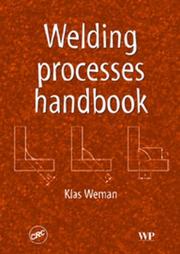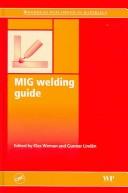| Listing 1 - 10 of 10 |
Sort by
|
Book
ISBN: 1628700629 0857095188 0857095102 9780857095183 9781628700626 9780857095107 Year: 2012 Publisher: Oxford ; Philadelphia : Woodhead Pub.,
Abstract | Keywords | Export | Availability | Bookmark
 Loading...
Loading...Choose an application
- Reference Manager
- EndNote
- RefWorks (Direct export to RefWorks)
The first edition of Welding processes handbook established itself as a standard introduction and guide to the main welding technologies and their applications. This new edition has been substantially revised and extended to reflect the latest developments.After an initial introduction, the book first reviews gas welding before discussing the fundamentals of arc welding, including arc physics and power sources. It then discusses the range of arc welding techniques including TIG, plasma, MIG/MAG, MMA and submerged arc welding. Further chapters cover a range of other important welding te

ISBN: 1855738538 9781855738539 020349976X 9780203499764 1855736896 9781855736894 9786610372997 6610372993 1280372990 0849317738 9780849317736 9781280372995 Year: 2003 Publisher: [Place of publication not identified] Woodhead Pub
Abstract | Keywords | Export | Availability | Bookmark
 Loading...
Loading...Choose an application
- Reference Manager
- EndNote
- RefWorks (Direct export to RefWorks)
This handbook is a concise, explanatory textbook for the main commercially significant and commonly used welding processes. It takes the student or novice welder through the individual steps involved in each process in a clear and easily understood way. It can be used as a textbook for the European Federation of Welding, Joining and Cutting (EWF) and International Institute of Welding (IIW) combined courses leading to the internationally recognised qualifications of Welding Engineer, Welding Technologist and Welding Specialist. It also covers many of the requirements referred to in European Standards including EN719 (on welding task responsibilities), EN 729 (on quality assurance), EN 729 (on welding procedures) and EN 287 (on welding training).
Digital
ISBN: 0857095188 9780857095183 9781628700626 1628700629 Year: 2012 Publisher: Oxford Woodhead Publishing
Abstract | Keywords | Export | Availability | Bookmark
 Loading...
Loading...Choose an application
- Reference Manager
- EndNote
- RefWorks (Direct export to RefWorks)
The first edition of Welding processes handbook established itself as a standard introduction and guide to the main welding technologies and their applications. This new edition has been substantially revised and extended to reflect the latest developments. After an initial introduction, the book first reviews gas welding before discussing the fundamentals of arc welding, including arc physics and power sources. It then discusses the range of arc welding techniques including TIG, plasma, MIG/MAG, MMA and submerged arc welding. Further chapters cover a range of other important welding technologies such as resistance and laser welding, as well as the use of welding techniques for cutting, surface cladding and hardfacing, soldering and brazing. A final group of chapters discuss more general issues such as mechanisation, safety, residual stress and distortion, welding design, costs and quality assurance, as well as the welding of steel and aluminium. The new edition of Welding processes handbook confirms its reputation as a concise, authoritative and practical introduction to welding and its applications for both students and engineers. It is designed to meet the requirements of Module 1: Welding processes and equipment of the International Institute of Welding (IIW) guidelines for the training of welding personnel at IWE, IWT, IWS and IWP level. This new edition has been substantially revised and extended to reflect the latest developments in the main welding technologies and their applicationsReviews gas welding and discusses the fundamentals of arc welding, including arc physics and power sources, before covering the range of arc welding techniques, including TIG, plasma, MIG/MAG, MMA and submerged arc weldingExamines a range of important welding technologies, such as resistance and laser welding and the use of welding techniques for cutting, surface cladding and hardfacing, soldering and brazing.

ISBN: 1855738538 9781855738539 020349976X 9780203499764 1855736896 9781855736894 9786610372997 6610372993 0849317738 9780849317736 1280372990 9781280372995 Year: 2003 Publisher: Cambridge Woodhead.
Abstract | Keywords | Export | Availability | Bookmark
 Loading...
Loading...Choose an application
- Reference Manager
- EndNote
- RefWorks (Direct export to RefWorks)
This handbook is a concise, explanatory textbook for the main commercially significant and commonly used welding processes. It takes the student or novice welder through the individual steps involved in each process in a clear and easily understood way. It can be used as a textbook for the European Federation of Welding, Joining and Cutting (EWF) and International Institute of Welding (IIW) combined courses leading to the internationally recognised qualifications of Welding Engineer, Welding Technologist and Welding Specialist. It also covers many of the requirements referred to in European Standards including EN719 (on welding task responsibilities), EN 729 (on quality assurance), EN 729 (on welding procedures) and EN 287 (on welding training).
Book
Abstract | Keywords | Export | Availability | Bookmark
 Loading...
Loading...Choose an application
- Reference Manager
- EndNote
- RefWorks (Direct export to RefWorks)
Book
Abstract | Keywords | Export | Availability | Bookmark
 Loading...
Loading...Choose an application
- Reference Manager
- EndNote
- RefWorks (Direct export to RefWorks)

ISBN: 1845691474 9781845691479 185573947X 9781855739475 0849391121 9780849391125 Year: 2006 Publisher: Boca Raton, FL CRC Press
Abstract | Keywords | Export | Availability | Bookmark
 Loading...
Loading...Choose an application
- Reference Manager
- EndNote
- RefWorks (Direct export to RefWorks)
Gas metal arc welding (GMAW) also referred to as MIG (metal inert gas) is one of the key processes in industrial manufacturing. MIG welding guide provides comprehensive, easy-to-understand coverage of this widely used process. The reader is presented with a variety of topics from the choice of shielding gases, filler materials, welding equipment and lots of practical advice. The book provides an overview of new developments in various processes such as: flux cored arc welding; new high productive methods; pulsed MIG welding; MIG-brazing; robotic welding applications and occupational health and.
Book
ISBN: 9782100752904 Year: 2016 Publisher: Paris Dunod
Abstract | Keywords | Export | Availability | Bookmark
 Loading...
Loading...Choose an application
- Reference Manager
- EndNote
- RefWorks (Direct export to RefWorks)
Book
ISBN: 9782100510955 Year: 2007 Publisher: Paris : Dunod ; L'Usine Nouvelle,
Abstract | Keywords | Export | Availability | Bookmark
 Loading...
Loading...Choose an application
- Reference Manager
- EndNote
- RefWorks (Direct export to RefWorks)

ISBN: 1280544708 9786610544707 1845691474 185573947X 9781845691479 9781855739475 0849391121 9780849391125 Year: 2006 Publisher: Cambridge, England ; Boca Raton, Florida : Woodhead Publishing Limited : CRC Press,
Abstract | Keywords | Export | Availability | Bookmark
 Loading...
Loading...Choose an application
- Reference Manager
- EndNote
- RefWorks (Direct export to RefWorks)
Gas metal arc welding (GMAW) also referred to as MIG (metal inert gas) is one of the key processes in industrial manufacturing. MIG welding guide provides comprehensive, easy-to-understand coverage of this widely used process. The reader is presented with a variety of topics from the choice of shielding gases, filler materials, welding equipment and lots of practical advice. The book provides an overview of new developments in various processes such as: flux cored arc welding; new high productive methods; pulsed MIG welding; MIG-brazing; robotic welding applications and occupational health and
Gas metal arc welding. --- Gas metal arc welding --- Carbon dioxide arc welding --- Electrogas welding --- Magnetic flux welding --- Metal inert gas welding --- MIG welding --- Electric welding
| Listing 1 - 10 of 10 |
Sort by
|

 Search
Search Feedback
Feedback About UniCat
About UniCat  Help
Help News
News